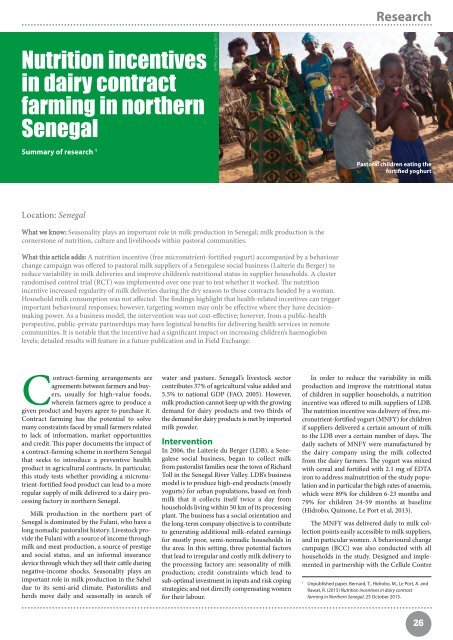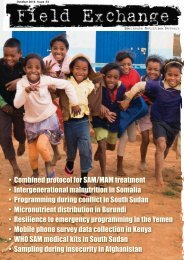Special focus on nutrition-sensitive programming
21dWhgZ
21dWhgZ
Create successful ePaper yourself
Turn your PDF publications into a flip-book with our unique Google optimized e-Paper software.
.....................................................<br />
Research<br />
. . . . . . . . . . . . . . . . . . . . . . . . . . . . . . . . . . . . . . . . . . . . . . . . . . . . . . . . . . . . . . . . . . . . . . . . . . . . . . . . . . . . . . . . . . . . . . . . . . . . . . . . . . . . . . . . . . . . . . . . . . . . . . . . . . . . . . .<br />
Nutriti<strong>on</strong> incentives<br />
in dairy c<strong>on</strong>tract<br />
farming in northern<br />
Senegal<br />
Summary of research 1<br />
IFPRI, Senegal, 2013<br />
Pastoral children eating the<br />
fortified yoghurt<br />
Locati<strong>on</strong>: Senegal<br />
What we know: Seas<strong>on</strong>ality plays an important role in milk producti<strong>on</strong> in Senegal; milk producti<strong>on</strong> is the<br />
cornerst<strong>on</strong>e of nutriti<strong>on</strong>, culture and livelihoods within pastoral communities.<br />
What this article adds: A nutriti<strong>on</strong> incentive (free micr<strong>on</strong>utrient-fortified yogurt) accompanied by a behaviour<br />
change campaign was offered to pastoral milk suppliers of a Senegalese social business (Laiterie du Berger) to<br />
reduce variability in milk deliveries and improve children’s nutriti<strong>on</strong>al status in supplier households. A cluster<br />
randomised c<strong>on</strong>trol trial (RCT) was implemented over <strong>on</strong>e year to test whether it worked. e nutriti<strong>on</strong><br />
incentive increased regularity of milk deliveries during the dry seas<strong>on</strong> to those c<strong>on</strong>tracts headed by a woman.<br />
Household milk c<strong>on</strong>sumpti<strong>on</strong> was not affected. e findings highlight that health-related incentives can trigger<br />
important behavioural resp<strong>on</strong>ses; however, targeting women may <strong>on</strong>ly be effective where they have decisi<strong>on</strong>making<br />
power. As a business model, the interventi<strong>on</strong> was not cost-effective; however, from a public-health<br />
perspective, public-private partnerships may have logistical benefits for delivering health services in remote<br />
communities. It is notable that the incentive had a significant impact <strong>on</strong> increasing children’s haemoglobin<br />
levels; detailed results will feature in a future publicati<strong>on</strong> and in Field Exchange.<br />
C<strong>on</strong>tract-farming arrangements are<br />
agreements between farmers and buyers,<br />
usually for high-value foods,<br />
wherein farmers agree to produce a<br />
given product and buyers agree to purchase it.<br />
C<strong>on</strong>tract farming has the potential to solve<br />
many c<strong>on</strong>straints faced by small farmers related<br />
to lack of informati<strong>on</strong>, market opportunities<br />
and credit. is paper documents the impact of<br />
a c<strong>on</strong>tract-farming scheme in northern Senegal<br />
that seeks to introduce a preventive health<br />
product in agricultural c<strong>on</strong>tracts. In particular,<br />
this study tests whether providing a micr<strong>on</strong>utrient-fortified<br />
food product can lead to a more<br />
regular supply of milk delivered to a dairy processing<br />
factory in northern Senegal.<br />
water and pasture. Senegal’s livestock sector<br />
c<strong>on</strong>tributes 37% of agricultural value added and<br />
5.5% to nati<strong>on</strong>al GDP (FAO, 2005). However,<br />
milk producti<strong>on</strong> cannot keep up with the growing<br />
demand for dairy products and two thirds of<br />
the demand for dairy products is met by imported<br />
milk powder.<br />
Interventi<strong>on</strong><br />
In 2006, the Laiterie du Berger (LDB), a Senegalese<br />
social business, began to collect milk<br />
from pastoralist families near the town of Richard<br />
Toll in the Senegal River Valley. LDB’s business<br />
model is to produce high-end products (mostly<br />
yogurts) for urban populati<strong>on</strong>s, based <strong>on</strong> fresh<br />
milk that it collects itself twice a day from<br />
households living within 50 km of its processing<br />
plant. e business has a social orientati<strong>on</strong> and<br />
the l<strong>on</strong>g-term company objective is to c<strong>on</strong>tribute<br />
to generating additi<strong>on</strong>al milk-related earnings<br />
for mostly poor, semi-nomadic households in<br />
the area. In this setting, three potential factors<br />
that lead to irregular and costly milk delivery to<br />
the processing factory are: seas<strong>on</strong>ality of milk<br />
producti<strong>on</strong>; credit c<strong>on</strong>straints which lead to<br />
sub-optimal investment in inputs and risk coping<br />
strategies; and not directly compensating women<br />
for their labour.<br />
In order to reduce the variability in milk<br />
producti<strong>on</strong> and improve the nutriti<strong>on</strong>al status<br />
of children in supplier households, a nutriti<strong>on</strong><br />
incentive was offered to milk suppliers of LDB.<br />
e nutriti<strong>on</strong> incentive was delivery of free, micr<strong>on</strong>utrient-fortified<br />
yogurt (MNFY) for children<br />
if suppliers delivered a certain amount of milk<br />
to the LDB over a certain number of days. e<br />
daily sachets of MNFY were manufactured by<br />
the dairy company using the milk collected<br />
from the dairy farmers. e yogurt was mixed<br />
with cereal and fortified with 2.1 mg of EDTA<br />
ir<strong>on</strong> to address malnutriti<strong>on</strong> of the study populati<strong>on</strong><br />
and in particular the high rates of anaemia,<br />
which were 89% for children 6-23 m<strong>on</strong>ths and<br />
79% for children 24-59 m<strong>on</strong>ths at baseline<br />
(Hidrobo, Quin<strong>on</strong>e, Le Port et al, 2013).<br />
Milk producti<strong>on</strong> in the northern part of<br />
Senegal is dominated by the Fulani, who have a<br />
e MNFY was delivered daily to milk collecti<strong>on</strong><br />
points easily accessible to milk suppliers,<br />
l<strong>on</strong>g nomadic pastoralist history. Livestock provide<br />
the Fulani with a source of income through<br />
and in particular women. A behavioural change<br />
milk and meat producti<strong>on</strong>, a source of prestige<br />
campaign (BCC) was also c<strong>on</strong>ducted with all<br />
and social status, and an informal insurance<br />
households in the study. Designed and implemented<br />
in partnership with the Cellule C<strong>on</strong>tre<br />
device through which they sell their cattle during<br />
negative-income shocks. Seas<strong>on</strong>ality plays an<br />
important role in milk producti<strong>on</strong> in the Sahel<br />
1<br />
Unpublished paper. Bernard, T., Hidrobo, M., Le Port, A. and<br />
due to its semi-arid climate. Pastoralists and<br />
Rawat, R. (2015) Nutriti<strong>on</strong> incentives in dairy c<strong>on</strong>tract<br />
herds move daily and seas<strong>on</strong>ally in search of<br />
farming in Northern Senegal, 25 October 2015.<br />
. . . . . . . . . . . . . . . . . . . . . . . . . . . . . . . . . . . . . . . . . . . . . . . . . . . . . . . . . . . . . . . . . . . . . . . . . . . . . . . . . . . . . . . . . . . . . . . . . . . . . . . . . . . . . . . . . . . . . . . . . . . . . . . . . . . . . . .<br />
26



